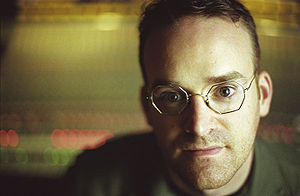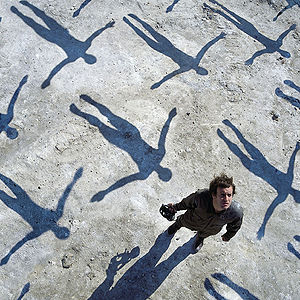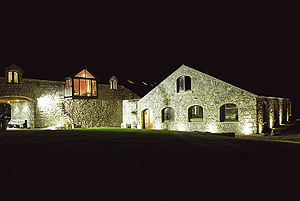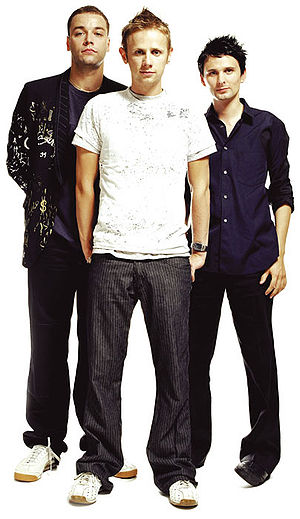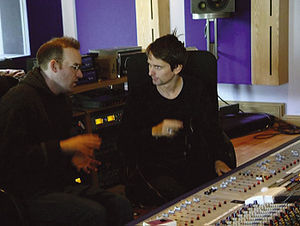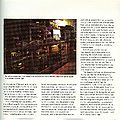Rich Costey: Recording Muse's Absolution (200312 Sound on Sound article)
To cite this source, include <ref>{{cite/soundonsound200312}}</ref>
Rich Costey: Recording Muse's Absolution
Published in SOS December 2003
With their number one album Absolution, British three-piece Muse have established themselves as one of the most ambitious and innovative rock bands in the world — and in Rich Costey, they've found an engineer and producer who understands their aims and encourages them to experiment.
by Richard Buskin
"I believe that anything should be possible at any moment," says Rich Costey. "The records that I'm most fond of are ones where people have taken as many chances as possible in service of the material. The process itself may yield both successes and defeats, but you'll never know unless you're free to explore, and that's something an outfit like Muse is very comfortable with. Those guys have been playing together for a long time, and as a result they are completely fearless and will try anything. That's one of the reasons why we had such a good working relationship."
A guitarist in high school who turned to producing indie bands in Boston and New York, Costey spent three years as the in-house engineer at Looking Glass Studios in Manhattan during the mid-'90s, assisting modern classical composer Philip Glass, and it was there that he steeped himself in the experimental approach to recording that has characterised much of his subsequent work, including the aforementioned Muse's acclaimed new album Absolution.
"My time at Looking Glass was just a thrill for me," he recalls. "I had been a huge admirer of Philip's, and it was no trivial matter for me to be able to work on his records day after day. When you're mixing for him, he holds out the score the whole time to ensure that you can hear all of the parts and are following the dynamics, as he simply composes on paper in the traditional manner. One day I was mixing something for him, and he was describing some of his compositional methods — he would use his motifs in an almost modular fashion, plugging in and reusing different parts of the same material within the same piece — and he told me 'Attempting to exactly repeat a success is bound to seem a failure, whereas if you move forward it's far more likely to seem a success.'
"How that translates to me in terms of making records is that I tend to reject the notion that there's a sort of penned-in area regarding how rock music is supposed to sound. These days there's a certain guitar sound that people think of as the guitar sound, and that's unfortunate. Previously, artists were more comfortable pushing things forward and trying things out, and obviously there are still artists who do that, but not many. That's what I'm interested in doing, though it usually means a bit more effort and occasionally a bit of risk."
Finding The Muse
After relocating to Los Angeles in the late 1990s, Costey teamed up with Jon Brion to produce and mix Fiona Apple's second album When The Pawn Hits The Conflicts... This led to assignments from producer Rick Rubin, which included the mix of Rage Against The Machine's Renegades album in 2000. Since then, Costey has undertaken numerous mixing projects, as well as production and engineering for the likes of Dave Navarro and, most recently, the London-based Muse trio of guitarist/vocalist Matthew Bellamy, bassist Chris Wolstenhome, and drummer Dominic Howard.
Originally hailing from Teignmouth, Devon, the three began playing together at the age of 13, first as Gothic Plague, then as Fixed Penalty and Baby Rocket Dolls, before adopting their current name in 1997, when they released their eponymous debut EP on Dangerous Records. A second EP, 1998's Muscle Museum, led to critical acclaim, a rapidly growing live following, and a contract with Maverick in the US, and in the wake of albums Showbiz (1999) and Origin Of Symmetry (2001), the band have attracted plenty of interest thanks to songs that meld melodic, sometimes unconventional lead vocals with strains of grunge, punk, psychedelia and arena rock. All of these elements are prevalent on Muse's new album, Absolution.
"I had become a fan of theirs, particularly after hearing their last record," says Rich Costey. "This was conveyed to them by some mutual acquaintances and we decided to collaborate. They had worked with the same people for a while, and I think they were interested in mixing it up a bit. By the time that I came into the picture, they had already recorded several tracks for the new album with John Cornfield and Paul Reed: 'Butterflies And Hurricanes' and 'Blackout' were among them. Those had gone very well, but they were interested in trying out some other ideas and seeing what else might be out there."
Costey would end up mixing 'Blackout', which utilised mandolin and real strings recorded at AIR Lyndhurst in north-west London, and recutting the vocal, bass and piano on 'Butterflies And Hurricanes'.
"Initially, we went to AIR just to see how things would work out between us," he recalls. "I did what I normally do, and they sat back and observed me. In retrospect it's kind of funny, because now, having gotten to know them so well, I realise they were a bit coy. There was also something of a continental divide between the American use of superlatives and the more reserved English use of them, but I wasn't aware of this at the time. For instance, soon after we went into AIR, my engineer Wally Gagel and I got what I thought was a great sound for the band to track live, and when I finally rolled some tape and they came in the control room to listen back, I thought they'd be over the moon. However, their response was along the lines of 'Uh, yeah, it's fine. All right, let's crack on...' and I felt deflated. It turned out that they did like it, but they were simply a bit reserved. They loosened up later — and I'm sure I did, too — when we got to know each other better.
Tractors & Water Sports
Opting for a rural residential facility to complete the recording sessions for Absolution, the band members located Grouse Lodge in Ireland via the Internet, and it turned out to be a successful choice. "We just showed up and took our chances, and the place was fantastic," Costey remarks. "We had a great time there. It's the only place I've ever been where there are windows all the way around the control room and tracking room. And it was kind of funny, because at one point Dominic was in the live area while we were sitting in the control room, and just as he was playing a really intense drum part, some guy on a tractor drove by the window that was behind him. You don't see that too often in a studio! Fortunately the isolation was good — there's no tractor on the record.
"Grouse Lodge has a Neve VR, and although it was a good-sized board, we still brought in 14 [Neve] 1073s and several [UREI] 1176s as well as some Pultec EQs. The studio contacted a number of rental companies for additional mic pres, and apparently that was all we could get because Iron Maiden were tracking somewhere and using up all of the other 1073s in the UK. "Of course, one of the advantages of a residential studio is that you can just kind of take over the place, and so we were able to do things like set up mics in the residences, while for the song 'Ruled By Secrecy' I had this idea that I wanted the drums to be intimate and very close, yet with a unique distant ambience. At one point, while we were rehearsing in the smaller Studio B, the band was running through the number with the doors open and I could hear it echoing around the courtyard. It sounded fantastic, so one afternoon while we were tracking I decided to set up the drums outside. We brought out a whole bunch of mic pres to ensure that the mic line was as short as possible, and we spent a number of hours setting this all up. "The kit was backed up into a sort of corner, with brick on one side and stone masonry on the other, alongside a tractor. Directly behind it was open, and it was good that Dominic was close to the wall because that enabled him to get a little more bass out of his kit. We set up a couple of distant mics and ran them through some Neves, and then I sat down in the control room and he started playing... and it sounded terrible. I think we captured one take, but we didn't use it at all. We got a little bit of ambience out of the courtyard, but the overall sound was unbearably thin and it just didn't have the presence that I'd expected.
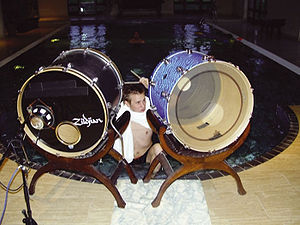
"Still, one idea that we did try and that was really good found its way onto the tracks ' Apocalypse Please' and 'Time Is Running Out'. The intro to 'Apocalypse Please' has a tom section, and I really wanted that to sound just ridiculous and as epic as possible. So, lo and behold, the studio had a swimming pool, which of course was full of water, and what we did was bring over a couple of kick drums, put them on stands, and miked one of them really close with the disembodied woofer of an NS10 to get a low, thumping sound, while a few C12 ambient mics were placed in the swimming pool area. We also had to bring mic pres into the pool area for all the same reasons, and Wally and I set things up so that Dominic could actually stand in the water while he was playing, just because it looked really good."
So, were there any lapping sounds? "Not during that section, although we did do some hot-tub overdubs later on. We did a couple of takes of the bubbling water, but again we didn't use it. In fact, we did a bunch of stuff. I'd seen a modern classical performance a few years back where there was a whole back line of people hitting gongs and dipping them in water. The water gong is not an unusual 20th-century classical instrument, but as we were gong-poor, we took some samples of doing the same thing with cymbals, hitting them loads and loads of times while dipping them into the water. Of course, cymbals have nowhere near the sustain and heft of an actual gong, and whatever they did have would dissipate as soon as they went into the water, so that was pointless. But it was funny.
"One thing that actually was useful was recording a couple of takes of Chris diving into the pool — we used that on the start to the bridge of 'Thoughts Of A Dying Atheist'. Listen really closely and, right where the bridge hits, you can hear him jumping into the pool. We used rather nice microphones to capture that, so we made sure to keep them clear of the water, and we also had to move really quickly because I was concerned about humidity affecting the mics."
Reaching For The Overheads
"I didn't want to do anything that sounded like their previous records. I liked Origin Of Symmetry quite a lot, but one of the reasons why I thought I might make a good producer for Muse is that I believed I could hear what they were reaching for and felt there were moments where they weren't quite getting there. For example, it struck me that at their basic level they wanted to sound like a colossal, dynamic, epic and powerful rock band, but there were a lot of moments on their past two records when they didn't quite achieve that. So, the first thing I wanted to do was make sure that they sounded pretty damned big and aggressive when they were supposed to, and that was down to the recording methods as well as their performance.
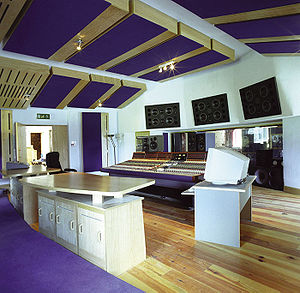
"For their part, the guys had heard some of my mixes for Rage Against The Machine and Audioslave and they were quite keen to get a sound that was just as big and assertive. They play extremely well together and they sound quite powerful on their own, but as usual we needed to explore different drum kits to obtain the right sound. Dominic's very good at tuning his drums and Chris has his own bass tone down really well — he's got three amps with different degrees of distortion coming out of each. I also brought in a Diesel guitar head, which I'm pretty fond of, and Matthew played a bit through that as well as his own custom Marshall, and overall I set them up a bit differently to what they were used to.
"In fact, I spent quite a while trying to sort out the drum sound, because Dominic is a pretty aggressive drummer and he tends to hit his cymbals rather hard. A bit of thought went into how to have the individual drums sounding defined without being washed out by the cymbals, and to that end I did something that I wouldn't recommend anyone doing carelessly, using far too many microphones. For overheads you might use a stereo pair, maybe accompanied by a mono microphone, but we ended up using that for an overall kit sound and tight-miking each of the cymbals. I myself normally use [AKG] C12s, and then for the close mics I use [Neumann] KM84s whenever they can be found, and I'll slightly mix those in to get a lot of attack — that way, the overheads themselves can be fairly low, and you can mix up the attack of the cymbals without the overall sound being too brash.
"Chris's monstrous amp rig consisted of three Marshall bass heads and three different Marshall cabinets, and how much room we had in any given studio basically determined what size of cabinets we set up. One of them produces a cleaner bass tone, while the second amp largely goes through [an Electro-Harmonix] Big Muff [distortion pedal], as well as a few other pedals that he'll occasionally hit. Then his third amp, which is the most distorted, uses an obscure Japanese distortion pedal, which is pretty weird, expensive and apparently difficult to find. It has a real nasally tone that doesn't necessarily make any sense on its own, but when you mix it within the context of the rest of the bass sound it's critical to what Chris wants. He has several bass guitars, and there's a well-worn Pedulla that he's particularly fond of.
"I like to use condenser mics whenever possible on the bass cabinets. They tend to have a much more open sound, the transients come through a lot stronger, and the net result sounds a lot more like you're standing in front of the amp. There certainly is a place for dynamics and I am a fan of them as well, but to me they colour the sound much more than a good condenser. That having been said, I've actually got a fair bit into recording the bass with this mic made by Blue, called the Mouse. Wally Gagel and I used it last year on the Antenna album by Cave In and it was excellent, so I used that on Chris's bass rig and I also used it on the snare, doubled with an SM57 whenever possible. I sometimes use a Neumann FET47 to record the bass, but Chris's rig was so loud that I didn't think we could get away with that — nowadays, I think people play much louder than they did when 47s were introduced, and one of the advantages with a newer mic like the Blue is that it can take a stunning amount of level.
"Aside from that, we used a pretty standard setup on the bass: [Sennheiser] 421s and [Electro-voice] RE20s. We tried a whole host of things while working at different studios, and we used different stuff each time. The full band was set up at AIR in the lead-up to Christmas, and then a couple of months later we set up at a place in Ireland called Grouse Lodge, where we did the majority of the recording over the course of about four weeks. We didn't have exactly the same microphones to choose from there, but we tried to copy the AIR setup as much as possible so that the basic tracks didn't sound totally foreign next to one another."
Learning Reserve
Muse singer Matthew Bellamy hits some pretty amazing vocal notes on the new record, most notably on cuts such as 'Apocalypse Please', 'Time Is Running Out', 'Hysteria', 'Blackout' and 'Butterflies And Hurricanes'. "He has an amazing voice and an amazing range," confirms Rich Costey. "He is completely confident with what he's doing. He'll just get in and, in three takes, he'll have everything he needs. Sometimes, with the vocals, not unlike the rest of the process, we would try out different things, different directions even once we knew we had something great, and while this would occasionally produce improved results, most of the time it wouldn't because Matthew's own first instinct was exactly right. "In terms of the vocal mics, we would switch between different ones according to the song. I'm a big believer in that as well. For example, he sang 'TSP' into a [Shure] SM7 that I had — one of the advantages for many singers who do a lot of shows is that they can grab hold of the SM7, carry it around the room and do whatever they want without creating very much handling noise. To me, that sounds quite a bit better than your more typical SM58, which a lot of people might use in the studio. The singer can press his face right up against the microphone without any worry whatsoever, so we used that on a few songs, while we mainly used a C12 for Matt on most of the more sedate vocals. Then again, in the case of 'Endlessly', we tried out a few mics — we tried an RCA 44, but that was just a little too dark, so we ended up going with the 77. "Matthew has tremendous vocal capabilities, and if anything he's still learning what those capabilities are. I think one of the things that he became more comfortable with during this project was the ability to sing in a little more reserved fashion. Like on the verses of 'Sing For Absolution', his tenor voice is very quiet and just beautiful, whereas normally he's pushing himself quite hard. Any time you work with a great vocalist it's pretty exciting. "Matthew's styling determined, to some degree, what I'd want to do with his vocals. For example, when he's singing loud, part of his sound frequently amounts to clipping the mic pre — I'd deliberately clip the mic pre on 'Time Is Running Out' as he sang louder and louder, adding more intensity and grit to his vocal. Distorting a vocal is so commonplace nowadays that to me it's the same as distorting a guitar or a bass. And much of the time when I'm mixing records for other people I'm distorting the vocal... whether they know it or not!"
Things That Have Character
In the months between the AIR and Grouse Lodge sessions (see box), Matthew Bellamy did more songwriting and Rich Costey took care of overdubbing some of the first-batch songs at AIR: 'Sing For Absolution', 'Stockholm Syndrome', 'Hysteria', 'TSP' and 'Fury' (which would end up as a bonus track on the Japanese release). These were then completed at North London's Livingstone Studios during a 10-day period following the Christmas/New Year break.
"We used the custom vintage Neve console at AIR, and whenever possible I only monitor on ATC SCM20s, which they also had there," says Costey. "Every facility was booked at the last minute, and when you're going from studio to studio it's really a crap shoot as to what you're listening to. On the other hand, the console at Livingstone was an SSL G-series, and it made a big difference switching to that from the vintage Neve. We rented a bunch of Neve 1073s to use as front-end mic preamps, and I also brought my old Universal Audio 1108s with me to warm up the sound. The UA mic pres are Class AB, whereas the 1073s are Class A. I largely only record through vintage Neves, but in this case we couldn't find a UK studio with one at short notice, and while I wasn't able to completely match the sound, I didn't mind that. I find it tedious when records sound the same all the way through. I'm much more interested in things that have character, and so long as they sound good, that's all that matters."
Matthew Bellamy's custom Manson guitars were mostly recorded through the aforementioned Diesel and Marshall amps running through a variet of cabinets. "The band played live together, facing each other in a semi-circle, and Matthew was singing, too, which he apparently doesn't normally do when they're cutting basic tracks," Costey explains. "Still, once we'd created those basics, it was a case of anything goes. I don't really believe in any hard and fast rules after that, and I don't necessarily like to go with one setup for a whole record. So, after we got the basics, we would try to push every single overdub to make it as interesting as possible.
"The way that I and the band chose to work — and I like to work this way, anyhow — was to concentrate on one song at a time for a while. I remember that we did quite a bit of work on 'Stockholm Syndrome' and 'Sing For Absolution' at AIR. We'd just put up a song, see what it needed, and explore it for hours, days, whatever, and then at the point where we felt we were slowing down we'd move on to the next thing. That process continued at Livingstone.
"On 'Sing For Absolution', I had a pretty clear idea as to what I wanted to hear on the chorus: big, broad-sounding guitars with a little bit of echo — it's hardly ever the case that something goes down without getting run through a [Maestro] Echoplex. I'm addicted to them, although recently both of mine unfortunately have gone ill on me. Still, I wanted the big, broad guitars with Matthew's voice just peeking out over them without being too far in front, keeping the chorus kind of subdued and real simple whereas the verses really needed to sound expansive and three-dimensional. We did some basic stuff at AIR on that song, and then when we got to Livingstone we spent time treating different pianos.
"The main piano sound on that song was heavily treated. I laid nails, guitar strings and all sorts of metal objects on top of the piano strings themselves so that they rattled, and then I miked all that with a pair of C12s. I had the dry piano coming into the console and I then split the signal so that half of it went to tape and the other half went to a [Digitech] Whammy pedal. In fact, the Whammy pedal also got split, so that half of it went to — no surprise here — an Echoplex and the other half went to a [Lovetone] Doppelganger pedal. That achieved a fake stereo, with a dry attack front and centre, while the Doppelganger with the echo was on one side and the Whammy's echo was on the other. Then we doubled it, so that it wasn't even fake stereo any more; it was two performances, which made a lot more sense.
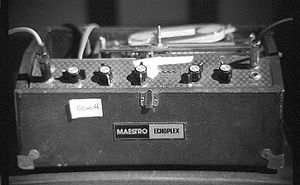
"Once we had that down, the song took on a much more melancholy sound, and thanks to the piano it also had kind of a broken sound which, I think, worked well with the lyrics. After that, we did some ambient passes of various synths running through different effects and doing volume sweeps while Matthew played throughout the song. We just wanted things to sweep in and out around the vocals."
Although the songs were all comped, with each of the band members performing a minimum of passes, Costey was keen to guard against too much editing. He typically treats Pro Tools as if it were a tape machine, not because of a retro mindset but simply in order to enhance the music by way of a more human touch, and he'd therefore utilise as much as possible of a single take before editing in parts only where this was absolutely necessary. The same applied to overdubs — he'd use as much as possible of complete takes, and never once was a performance flown into another section of a song.
"I made that mistake years ago," Costey admits, "and what ends up happening is that the record has a real thin veneer to it, almost like a genetically engineered tomato that looks perfect but has absolutely no flavour."
Three People Trying to Sound Like 10
The approach paid off. Absolution boasts a collection of very live-sounding tracks that convey the effect of the band members playing complete performances. Then again, in terms of aural imaging, for all of the reverb and power chords, the manner in which the instruments blend into one another creates a sense of the musicians being bunched close together within a fairly confined space.
"I think that's partly the design of the band," says Costey. "Because they're only a three-piece, Chris's bass tone is engineered from the ground up to go from the low lows of the bass through the bottom end of the guitar. And Matthew, by extension, because he switches quite frequently to the piano, doesn't necessarily feel like he has to carry the brunt of things with his guitar. What you have is three people trying to sound like 10, and they've got it down pretty good, so that their instruments sonically tend to overlap one another, and the way they play off each other tends to overlap more than it does with a lot of other bands. Often you hear bass players who tend to double the guitar roots very low and function as a mere guitar support, but that isn't the case with Muse.
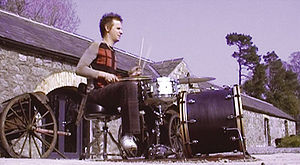
"At the same time, another reason for the tight sound may be that I don't tend to use much reverb on things like drums when I'm mixing. I pretty much just used whatever ambience was to be found on the room mics. Then again, when we were at Grouse Lodge in Ireland, we occasionally augmented things in terms of the drum sound, and this was especially so on 'Falling Away With You'. We ran a couple of Earthworks mics way down to the other end of the building, in the hallway towards the residences, and the track had this ridiculous, cavernous pomposity to it. This wasn't very useful if the drum part was busy, but if it was a simple part then it sounded terrific, and so there were a couple of moments where I cranked those up quite a bit."
One notable aspect of 'Falling Away With You', which starts off as a ballad before seguing into heavy rock, is the prevalent sound of Matthew Bellamy's fingers sliding on the strings of his guitar. "That's simply the sound of a human playing guitar," says Costey. "Matthew was playing his black Manson guitar very quietly through an Overbuilt amp, and all we added was a bit of reverb, so it was fairly clean. However, if you run just a little bit of compression you're bound to enhance those finger noises. A lot of people find them distracting, but for me that's the sound of someone playing an instrument. I have worked with people who play in such a manner that you don't hear any finger noises at all, and in those cases I just defer to the musician, but with Matthew you can hear the sound of his fingers on the strings, and this created a kind of intimacy that perfectly suited the quiet section of 'Falling Away With You'."
On some tracks, Matthew Bellamy didn't want to track his vocals until he really had a feel for where the music was going to lead him, whereas on others he'd record his part and, in so doing, highlight the fact that some more musical texture needed to be developed underneath the vocal. One example of this was the song 'Endlessly', with its loungey-sounding Wurlitzer intro and backwards cymbal and conga during the short instrumental break.
"That song was really a work in progress up until almost the last minute, and we took a different sort of vocal approach with it," Costey recalls. "Obviously, it's too slow to be a dance number, but there is a kind of subdued four-to-the-floor, 909-sounding rhythm going on throughout the track. That's largely due to the fact that Matthew did a couple of demos, and one of them featured him performing on a piano as well as a drum machine that was playing that pattern. There was such an honesty to it and a directness to it that even though we tried it with a full band approach, nothing seemed to work as well as what he had on that demo, which was just a real pure intro and a really heartfelt vocal. We therefore took that approach and built on it, and we had Dominic play loads of different drum patterns within that tempo and then actually cut up ones that had kind of a light jazz feel with a couple of fills."
More Chet Baker, Less Arthur Baker
After the work was completed at Grouse Lodge, the project switched location once again, this time to Cello Studios in Los Angeles, where three weeks were spent overdubbing before the mix then took place. It was here, during the overdubs, that 'Endlessly' really came together.
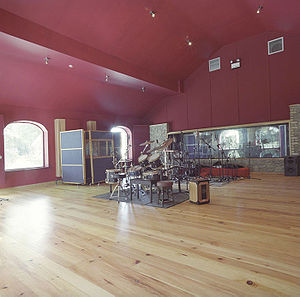
"Although we were happy with the drumming aspects of the song, we were still dissatisfied with a lot of it," Costey explains. "We were in Studio Three, where the Beach Boys had once recorded Pet Sounds [when the facility was still known as United Western Recorders], so we tried to conjure up the spirit of Brian Wilson by bringing in an old S6 tube monophonic synthesizer. I mostly wanted Matthew to use it to play some arpeggios, but those didn't end up sounding very good, and so he then reached over to these auto-chord figures on the left-hand side of the keyboard, where you can just hit one button and it will play the chord. Underneath it is a button that you can press to control the volume of that note, and while we were running the track down Matthew started playing the chords to the song and using the dynamic button to tap out a rhythm. That ended up being the main thing that the rest of the song was centred about: the real soft, moody, warm keyboard sound that plays in the chorus.
"At that point, we absolutely knew that we wanted the sound more Chet Baker and less Arthur Baker. So, Matthew sang into a big old RCA 77 ribbon mic, and we did a number of other overdubs on the track, but we tried to keep it as sedate as possible even if, by the end of the song, it gets a bit expansive. There's a treated type of opera vocal coming in later in the song, and we tried to be very careful with that, because it's a dangerous area."
Meanwhile, another song that starts off in fairly staid and straightforward fashion before building in force is 'Ruled By Secrecy', on which thundering piano bass notes are interspersed with high notes that ride over the top of the vocal. "A lot of the time we would actually cut the right-hand and left-hand parts separately and treat them separately," Costey remarks. "The beginning of 'Ruled By Secrecy' was all CP80, which is an old Yamaha electric piano, and while that was a left-hand part we also doubled it up with a right-hand part that was actual piano. We also took the CP80 and ran it through a couple of guitar amps only for the left hand, so that the left hand would have a larger tone to it when Matthew hit those notes. Then, by the end of the song, when he was hitting the more sustained left-handed parts, I trotted out the old Echoplex as well."
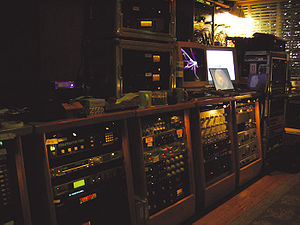
'Time Is Running Out' was probably the most difficult song for band and producer to nail down, especially with regard to an intro that required mucho experimentation. "We tried out all sorts of percussion ideas," says Costey, "including people clapping their hands and slapping their knees. At one point Wally even miked up Chris and Dominic scratching their heads to produce a shaker track, and that worked suprisingly well, but we didn't end up using it. Eventually, we concluded that the bass would comprise the centrepiece of the intro, so we had to come up with a unique, very characteristic tone, although I wasn't totally convinced about the bass line that we initially settled on. We spent an entire day trying to get the greatest bass intro sound ever created in all humanity, and by the end of that time we went with an acoustic bass guitar running through a ton of pedals and different amps. Then, just as we'd attained a sound that we thought was pretty good, Matthew walked in, listened to it and said, 'Fantastic, you've just spent eight hours on a flanged bass?' He was right of course, not having spent hours on the floor, toying with pedals and cables. We didn't keep any of it. Still, there was always good give-and-take like that, and we trusted each other enough to go with our respective ideas."
As most arrangement decisions regarding the songs were made while recording, the overall modus operandi amounted to settling on a direction that would subsequently determine the nature of the overdubs and then the mix. This, in turn, ensured that the mixing process was relatively short and strightforward; about three weeks in all.
"The biggest challenge on Absolution was making sure that the whole thing hung together cohesively," Costey asserts. "We tried out so many different ideas, and in a couple of songs we didn't get the arrangements totally nailed down until it was time to mix. At that point, if you're not happy with something it's too late to go back and change it. So, during the last week there was a certain amount of making sure that all those loose ends were dialled in, and that the songs sounded good next to one another and sounded like the same band. Hopefully, that's what we achieved. By the end, for all of their British reserve and my over-the-top American enthusiasm, the guys were very excited about this record — and so, of course, was I."
Published in SOS December 2003

